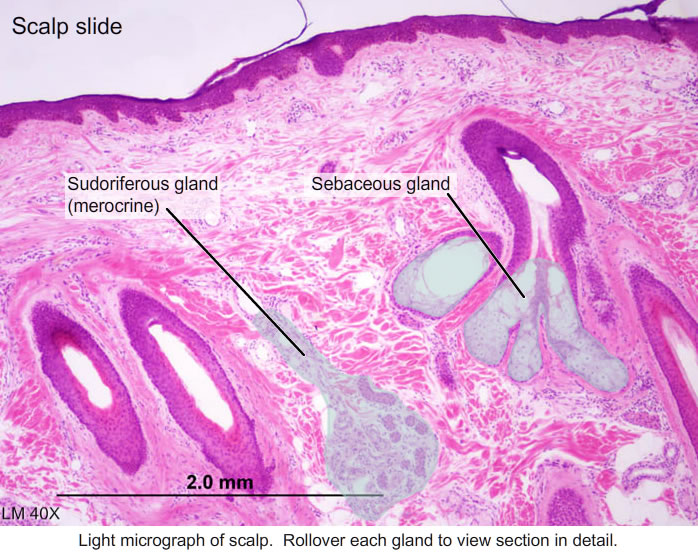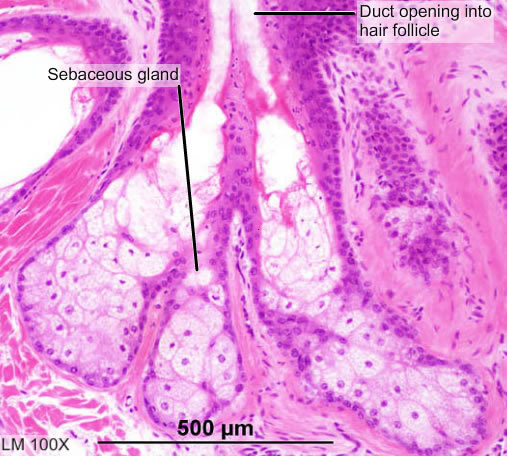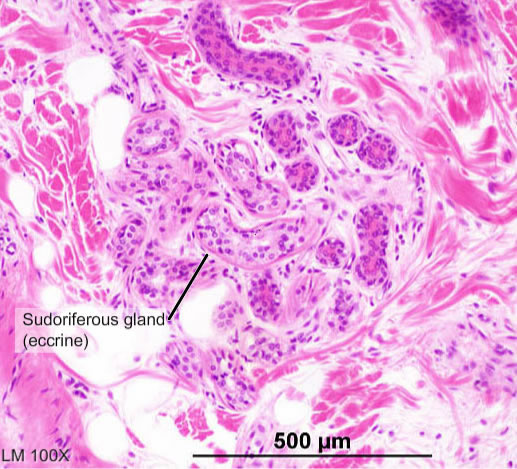The Glands
- Identify the function and location of sudoriferous glands. Differentiate between eccrine and apocine sweat glands.
- Identify the function and location of sebaceous glands.
- Identify the function and location of mammary and ceruminous glands



Sudoriferous glands- also called sweat glands include merocrine (eccrine) and apocrine glands. Both types of glands produce perspiration and release it via exocytosis into ducts; however, the consistency of the perspiration and the structure and primary locations of these glands are different.
Merocrine glands are located throughout the body but are particularly numerous at the palms of the hands, soles of the feet and forehead. These glands produce a watery perspiration that functions in cooling the body via evaporation. The glands are simple tubular glands, each organized as coils at the dermis with a twisting duct leading to a sweat pore at the surface of the skin.
Apocrine glands are primarily found at the axillae, genital area, and the areola of the nipple. The perspiration produced by aprocrine glands contains a large amount of fatty acids, resulting in a more viscous perspiration than that produced by merocrine glands. These glands develop during puberty and are considered to be scent glands. Apocrine glands are structurally similar to merocrine glands, except their ducts have larger lumens and empty into hair follicles.
Sebaceous glands - Sebaceous (oil) glands are associated with hair follicles and are located throughout the body except for the palms of the hands and the soles of the feet. They are most abundant at the face and scalp. Sebaceous glands produce an oily product called sebum and secrete it via short ducts into hair follicles, although a few release their product directly on the skin surface. Sebum functions to moisten hair and skin. Sebaceous glands are flask-shaped, each with a duct that empties into a hair follicle. The gland cells are holocrine in type, rupturing with the accumulation of their product and becoming part of the sebum. Inflammation of these glands due to blockage of the ducts, often with bacterial infection, is known as acne.
Mammary gland -The mammary glands are modified sweat glands that are found within the breasts. They are apocrine glands and are found in both sexes. In the female, these glands develop during puberty and become functional during pregnancy and lactation. The mammary glands produce milk that empties via ducts into the nipple for breast-feeding.
Ceruminous glands - The ceruminous glands are modified sudoriferous glands located in the external ear canal. The glands produce a waxy substance known as cerumen that functions in keeping the eardrum supple and waterproofing the ear canal. Ceruminous glands are organized as simple, coiled, tubular glands with ducts that empty onto the surface of the skin.